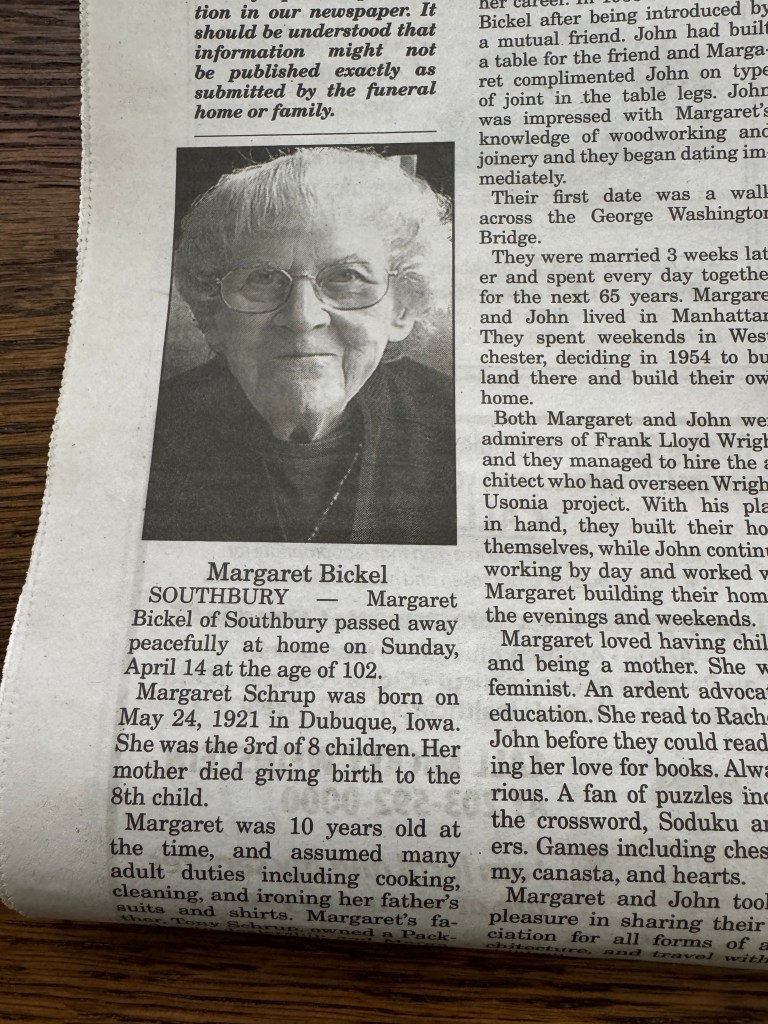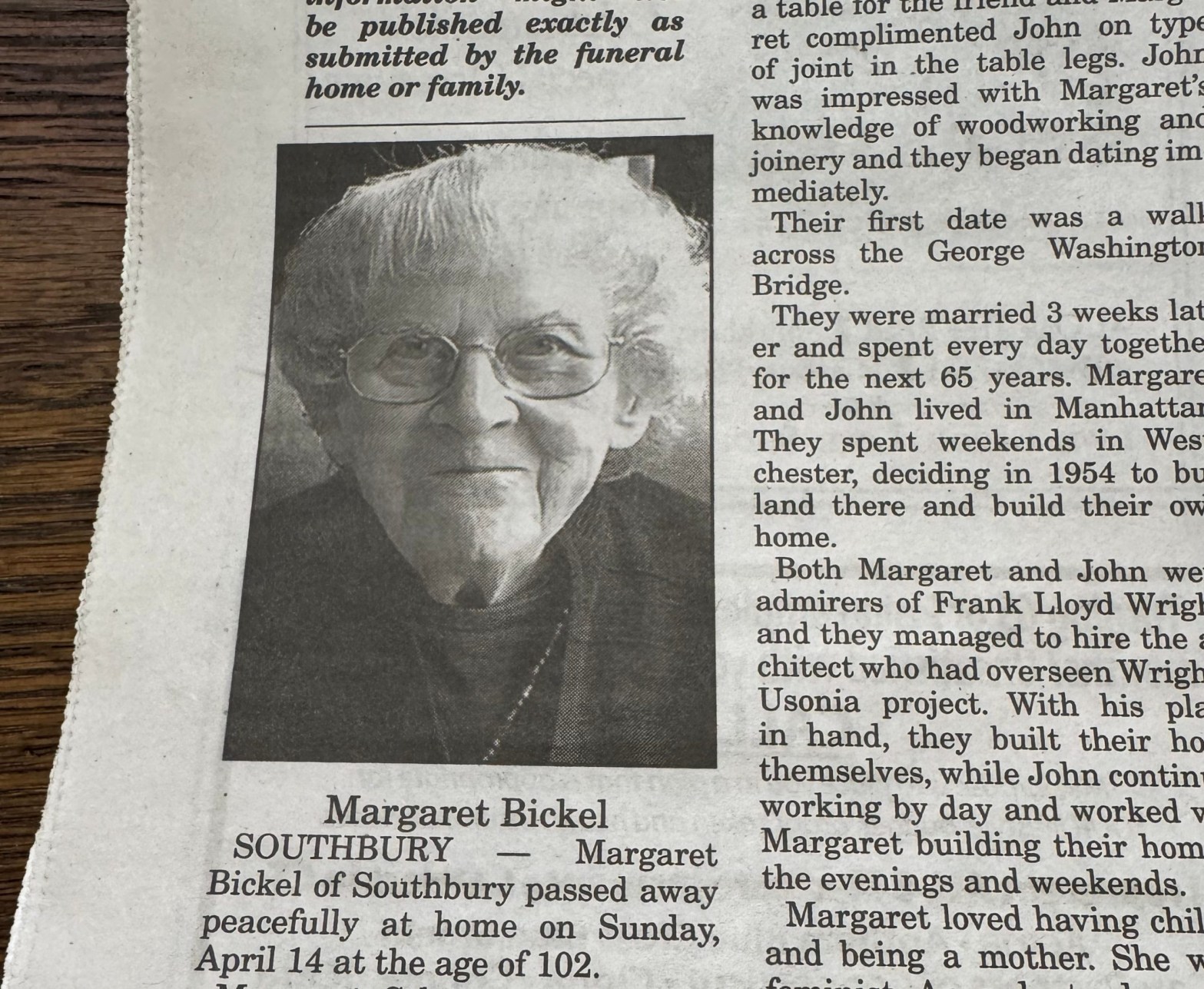Yesterday, we received our local weekly free newspaper, Voices, as we always do on Wednesdays.
If you live in the States, you probably get something similar: black and white, newspaper-printed, a round-up of state and town government goings-on, library awards, referendums, new restaurants and pizza joints opening up, pet rescues, tag sales, ongoing Appalachian Mountain Club/church groups/AA meetings. And obituaries.
Normally, one of us reads it while the other one makes dinner, but last night we stood side by side at our kitchen island and read about the life of Mrs. Margaret Bickel of Southbury, Connecticut, who died on April 14th at 102 years old. Neither of us knew Mrs. Bickel, but we would have liked to.
Maybe it is a function of age to read the obits, or the fact that I grew up this way: when I was a kid, my father read the New York Times obituaries every morning over breakfast, he said, to make sure he was still alive. Maira Kalman has written and spoken extensively about this practice; it is how she discovered the life of Megan Boyd, eccentric master of fish flies who once turned down an invitation from Queen Elizabeth wanting to present her with the British Empire Medal. Miss Boyd couldn’t leave her home in Golspie, Scotland because, apparently, she didn’t have anyone to watch her dog that day. An extraordinary person who called little attention to herself, Boyd dressed in her daily uniform of a man’s shirt and tie, sweater, wool skirt, tweed sports jacket, and heavy army-style boots. She had no electricity until 1985 and died in 2001, age 86.
Susan and I both come from long-lived family members: her maternal grandmother lived to 101, her mother lived to 94, my paternal aunt lived to 102, and my paternal grandmother lived to 93. We know the stories: Susan’s subsistence farmer grandmother was widowed at a very young age, left with ten children for whom she made clothes and shoes (we use one of her heavy iron shoe forms as a doorstop), and got through her days by taking ten-minute naps on her farmhouse kitchen floor; she was, according to all who knew her, somehow never without a smile. Once my uncle went off to fight the war in Europe, my intrepid aunt and her mother-in-law spent their days in front of a large map spread out on the kitchen table, trying to figure out where he was based on a secret, censor-defying code they devised involving numerical tags: it was, he wrote, 48 days since they’d last seen each other, and he was looking forward to getting home and watching his 11 year old niece grow up. Meaning: coordinates were roughly 48.7904 N latitude, and 11.4979 E longitude. They figured it out; he was in Bavaria.
My father told me these stories, so I don’t know how accurate they are because memories can be like a game of telephone, changing and changing again over the years. Nevertheless, they are stories that I treasure: Susan and I are members of the last generation linking the pre-computer, pre-selfie, Megan-Boyd-fly-tying world where it would take days and sometimes weeks to get a letter, to the Tik Tok/instant gratification universe where digital addiction and oppressive rage at people one doesn’t even know are a built-in component of everyday life.
My aunt and uncle, Susan’s grandmother, Susan’s mother, my father — they’re gone now, and evidence of that generation is disappearing. I have in my office direct reminders of it: the piles of letters that my father sent home from the Pacific, where he flew planes as a nineteen-year-old night fighter pilot in World War 2; a picture of his squadron hangs over my desk; a New York City municipal photo of my mother, grandmother, grandfather, and granduncle outside the Brooklyn furniture store they owned on Grand Street, circa 1938, when my mother was just three years old.

But back to Mrs. Bickel of Southbury, Conncticut. Here is what we learned last night.
SOUTHBURY — Margaret Bickel of Southbury passed away peacefully at home on Sunday, April 14 at the age of 102.
Margaret Schrup was born on May 24, 1921 in Dubuque, Iowa. She was the 3rd of 8 children. Her mother died giving birth to the 8th child.
Margaret was 10 years old at the time, and assumed many adult duties including cooking, cleaning, and ironing her father’s suits and shirts. Margaret’s father, Tony Schrup, owned a Packard auto dealership and Margaret started driving at age 14 and would drive a 12 cylinder Packard to transport her younger brothers and sisters to school.
Tony was also active in Democratic politics and in 1936 drove Franklin Delano Roosevelt around Dubuque during a campaign stop. Tony brought FDR by his home so all his children, including Margaret could meet him.
At eighteen she left home, moving to Minneapolis and learned about bookkeeping and accounting.
She took a job with Remington Rand and learned punch card accounting. During the 1940s, Margaret traveled extensively for Remington Rand helping customer convert from manual accounting to new punch card accounting systems.
She spent a lot of time in the south, in Houston and Albuquerque, and many other locations across the U.S.
In the early 1950s she moved to New York where she continued her career. In 1953 she met John Bickel after being introduced by a mutual friend. John had built a table for the friend and Margaret complimented John on type of joint in the table legs. John was impressed with Margaret’s knowledge of woodworking and joinery and they began dating immediately.
Their first date was a walk across the George Washington Bridge.
They were married 3 weeks later and spent every day together for the next 65 years. Margaret and John lived in Manhattan. They spent weekends in Westchester, deciding in 1954 to buy land there and build their own home.
Both Margaret and John were admirers of Frank Lloyd Wright, and they managed to hire the architect who had overseen Wright’s Usonia project. With his plans in hand, they built their home themselves, while John continued working by day and worked with Margaret building their home in the evenings and weekends.
Margaret loved having children and being a mother. She was a feminist. An ardent advocate for education. She read to Rachel and John before they could read, sharing her love for books. Always curious. A fan of puzzles including the crossword, Soduku and others. Games including chess, rummy, canasta, and hearts.
Margaret and John took great pleasure in sharing their appreciation for all forms of art, architecture, and travel with their children.
Margaret loved to read and read The NY Times every day and The New Yorker every week.
After John retired as a photographer in 1979, he started a second career with Margaret as a fine wood craftsman. Margaret participated by contributing design ideas and ran the business end of things.
She taught herself to use the IBM PC and VisiCalc, Multiplan and Lotus 1-2-3. The two began exhibiting their work at juried craft shows in the Northeast and mid-Atlantic regions, winning several awards and selling furniture. This second career lasted from 1980-2013.
In 2014 John and Margaret sold the home they built in Ossining, N.Y. and relocated to Southbury in Heritage Village. They joined several clubs and made new friends in Southbury. John passed away in 2018.
Margaret is survived by her children, John Bickel, Jr. and his wife Margaret of Southbury, and Rachel Bickel of Brattleboro, Vt.
The family would like to thank her caregiver Kuhle Madlingozi for the wonderful care and compassion given to our mom in her final days.
There will not be a service.
Rest in peace, Margaret.
This post was originally published on Elissa Altman’s blog Poor Man’s Feast, The James Beard Award-winning journal about the intersection of food, spirit, and the families that drive you crazy. Read more on her Substack, or keep up with her archives here.
Image courtesy of the author.
